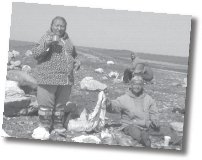
February/March .............................. Avuniukvik (season between winter and spring) March/April ...................................... Halunngnakvik (time to air skins outside iglus) April/May .......................... Nauvik/Naujalikvik (first sight of seagulls, snowbuntings) June/July ...................................................................... Kaumanik (24 hour daylight) July/August ............................................................ Maujakvik (fish heading up river) Sept/October ..................... Amiraijakvik (shedding of fur/rutting season of animals) October/November .................................................................................... Ukiakhak December/January ............................................................................................ Ukia February/March ................................................................................................ Ukiu April/May ............................................................................................. Upinngakhak June/July ................................................................................... Upinngua/Aujakhak August/September ............................................................................................. Auja
This is the way the Inuit understood the changes in the world around them.
When seal hunters catch a seal out on the sea ice, they eat the liver as a delicacy while it is still warm. The liver is taken out through a small hole cut near the stomach. A special tool was used to make several small holes on the seal’s skin so the skin could be pinned together using this tool and thus prevent the blood and meat from coming out of the animal.
A seal hunting kit was carried in the coldest months while hunting. This included an indicator that could be set up in the seal’s hole to tell when there was a seal below ready to pop up. The indicator was made of antlers tied with a sinew and put down to the bottom of the seal hole. The bottom of the hole would be thin ice that had recently frozen. When the seal rises, the indicator would rise with the water and tell when the seal is there. The indicator would go up and tell the hunter where the seal is.
A special bag made from caribou skins would be made to hold the bones, swan feathers, and other tools used for hunting seals. These tools could also be attached to the back of a caribou skin parka with a button so that you could reach behind you to get them. These tools were awesome to see. I myself have not used a lot of these tools and have only heard about them.

The way to hunt seals long ago required the hunter to stand using his harpoon. Hunters would make chairs of snow blocks while they waited for seals to show up. I remember once sitting on such a chair and feeling sleepy. I tried hard to stay a wake but I fell a sleep without realizing it. The next thing I heard was a big crash when I fell over and hit the snow. I got scared because I didn’t know what happened at first; I only heard the noise from my own fall.
Caribou were usually hunted by looking for their crossing places, rather than using blinds. Inuksuks would mark these places where long ago hunters had used qajaqs where the caribou crossed water. A hunter would try to use his spear according to a tradition rather than just stabbing anywhere. If a caribou was to the right of you, you wouldn’t use your left hand to stab it because this could tip you over. If the caribou is on your right, you should use your right hand to spear it so the qajaq will remain stable.
Note: Excellent story to teach Archimedes’ principle of flotation and the physics of buoyancy.